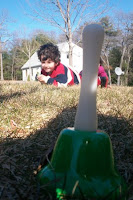Not too long ago, Danette over at
SOS Research let me know that her next
S-O-S- Best of Best would be on “family life as it relates to invisible special needs”. I knew I wanted to write on the topic, but have since found myself waylaid by repercussions of living life alongside Sensory Processing Disorder (SPD), or perhaps just managing life with children who have been sick and a Mama who tries to budget a seemingly infinite amount of things into an obviously finite amount of time. That is, I have been facing severe scattered focus and a deficit in time management.
Today, at the 11th hour, I combat both focus and time issues in order to share a suggestion that our family has discovered as a response to the challenges of SPD:
Embrace them!
Yep, the good, the bad, the ugly and the immeasurably indispensable. One and all. Accept and, sometimes, even accentuate them. When our family remembers to do so, life is so much better!
How?
Well, take, for instance, the good:
When the extended family begins to “get it”, special moments happen, such as this sensory break story time with auntie, hiding under a table during a boisterous family party.
The bad:
When your child is sick, things are never easy. A fever and vomiting in your average kid is trying. With an SPD kid, the flu can be downright terrible. One moment, a slight touch can be met with screams of, “Ow! You are hurting me!” as feverish skin becomes extra sensitive. The next moment, the umpteenth meltdown of the day can begin (as happened at our home today.) On the flip side, though, sickness can offer moments of treasured calm and cuddles – often the first time in weeks your child remains still in your arms and your house’s appearance does not suffer from his constant “getting into things”. We experienced such a sick-induced slow down several years ago on New Year's Eve and have been forewarned of colds and flues coming on by "the calm before the storm" a number of times since.
The ugly:
SPD-related melt downs rear their ugly heads out of nowhere, it often seems. And, once in full swing, they can be so hard to tame. But, as you try to organize your child, you can learn to do so with a sense of humor. Not too long ago, we did this very thing as our son carried on, “I don’t like Mommy! I don’t like Mommy” over and over even as he clung tightly to me during a prolonged tantrum. Irony can be amusing!
And, the immeasurably indispensable:
Heavy work can be a key ingredient in a daily sensory diet. A change of location (i.e. away from cabin fever) can be essential, too. More than once, we have found ourselves feeding our son’s sensory needs by heading out as a family when we normally would not. A recent walk in the woods on an nippy winter day was one of those times. Patience had been wearing thin. Input was in order. Desperation led us outdoors and delight awaited us there! Brother got his heavy work.
Daddy got his exercise.
Sister got a fun ride.
And Mommy and Baby enjoyed the hike.
Now, I am not saying that times when relationships are strained, patience wanes or frustration waxes never happen in our family. Most certainly, we experience moments of both literal and figurative heads beating against walls. However, since committing ourselves to embracing, instead of “fixing”, our son’s unique mix of thinking, acting and being, we find that life has been more manageable. As we continue to discern, diagnosis and deal with “it”, “it” has ceased to be a setback and begun to become an impetus for discovery.
Yes, we still feel exasperated at times, but we also enjoy a new found sense of anticipation and appreciation.
As my husband has often reminded me, imagine if Einstein, da Vinci, Beethoven, Newton or many other icons of eccentricity and possible special needs were medicated to “normalcy”. What would science, art and history be like then? Would today's families enjoy the conveniences and the culture that they do?
Most certainly, “normal”, “average” and “typical” have their places in this world – places where it is easy to fit pegs into holes. I daresay “different”, “unique” and “marching to the beat of one’s own drummer” have places, too. Places constructed of square pegs that can act as a firm foundation for all the incredible (and, incredulous) moments of life to be built upon.
Too often, when something is identified as “different”, folks classify it as “wrong”. The tendency is to look for ways to “fix” things, instead of simply accepting them as they are and recognizing them as the new “right”. As our family continues to navigate our SPD journey, we are embracing the “right”. In fact, I think my recent mantra has become, “No fixing, please. Just hold – to each other and until the next moment – and all will be as it should be.”
That mantra began to take shape one day as I drafted a poem as a part of Jennie Linthort’s wonderful
LifeSpeaks workshop. I share it below with the hopes that it might give a voice to the feelings of other families embracing invisible special needs.
No Fixing, Please
I see it in their eyes
I hear it in their voices
They cannot disguise
Their doubt
Sensory Processing Disorder?
What’s that?
The new ADD?
Hmm… perhaps not.
Perhaps it’s just you.
Your inadequate parenting.
You desire for an excuse.
There is nothing wrong with that child
That some good discipline could not fix.
Then, the others,
They project relief
Self-satisfaction
Or some combination of both.
Ah, there is something there.
We were right.
We knew something was going on.
It’s got a name now.
So, how do we fix it?
Fix it?
Fix it!
My child is not a broken piece equipment.
He is not a busted toy.
He is a boy.
My boy.
A boy loved by many.
Understood by few.
Confounding
Yet complete
No-matter-what-the-label-is-that-is-applied-to-him.
Look at him.
Not it.
He is an individual
Who needs love –
Strategies.
Not your judgments.
Not your pity.
Not reactions.
He needs action.
What action?
How about embracing for a start?
May all families facing invisible special needs take a moment to embrace one another and their special child today.





























